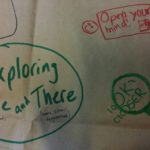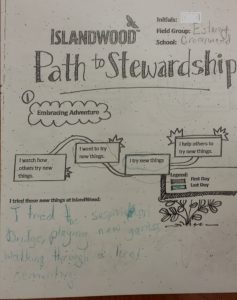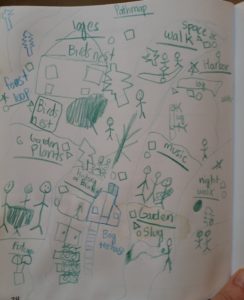The concept of stewardship can be difficult to explain to adults let alone 5th grade students. Additionally, reflecting upon one’s personal stance can feel intimidating and scary. To help students grasp the concept as well as acknowledge multiple viewpoints, I have recently begun using butcher paper to have a silent conversation on the topic of stewardship and what it means. At IslandWood, stewardship is broken down into 4 pillars: Embracing Adventure, Exploring Here and There, Helping the Environment, and Living and Learning in Community.  Each of these pillars is written at the center of a large piece of butcher paper and students are invited to mindmap their ideas for each pillar through words and drawings. Students rotate through each of the four papers, building off of each others ideas. The anonymity of this process encourages freedom of thought, lowering the risk for expression of ideas. Additionally the inclusion of drawing helps ensure inclusion for ELL students as well as reducing pressure for correct spelling.
Each of these pillars is written at the center of a large piece of butcher paper and students are invited to mindmap their ideas for each pillar through words and drawings. Students rotate through each of the four papers, building off of each others ideas. The anonymity of this process encourages freedom of thought, lowering the risk for expression of ideas. Additionally the inclusion of drawing helps ensure inclusion for ELL students as well as reducing pressure for correct spelling.

This activity is in preparation for the students to fill out their own personal Stewardship Pathmap, here they self-evaluate where they see themselves in relation to those four pillars. The mindmapping serves to generate a diversity of ideas about each pillar, illustrating there are multiple ways to regard the elements of stewardship. At the end of their week at IslandWood, the students revisit their Pathmaps and indicate if their thinking has changed regarding their mindset about stewardship. This is an opportunity for them to offer examples of how they may have embodied the pillars or how their thinking has changed about what a pillar may mean to them.
While the students only see their Pathmaps twice during their week at IslandWood, it is an activity that lends itself well with goal setting. Some weeks I ask each student to set a daily goal for themselves in relation to one pillar, ensuring that it is both realistic and achievable. The following day, we revisit our goals and check for accomplishment, by students honoring each other with specific evidence for their teammates. This idea of goal setting for stewardship is one method to help students transfer the learning that happens here at IslandWood back to their home community. In reflecting upon this combination of activities with the pillars and goal setting, this is something that I plan to implement with all my future students. In my opinion, the importance of goal setting and stewardship cannot be emphasized enough and I am going to strive to provide this opportunity for students.


Summer – I like the idea of doing this as a silent activity. Do you scaffold the definitions or allow students to write on the papers as a way of working out what the pillars mean? What are some ways that you encourage students to reach their goals throughout the day?